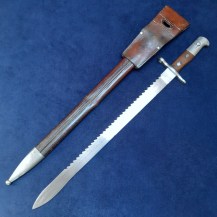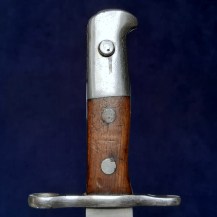Swiss M1914 Schmidt-Rubin Sawback Bayonet, Early Leather Scabbard
Straight spear pointed blade with sawback, swell point and false edge, with single fuller on one side, the other side completely flat. Steel hilt with upper muzzle ring and lower lobe quillon, beaked steel pommel with locking button. Wood slab grips secured by two steel rivets. Brown leather scabbard with steel throat and chape pieces, the throat piece with frog loop with attached leather strap, the chape piece with ball finial. Brown leather frog.
The blade is stamped at the ricasso with the manufacturer ‘Waffenfabrik Neuhausen’, and on the hilt with the serial number ‘90143’. The lobe quillon is stamped with a Swiss cross and circle. The scabbard finial is stamped with a Swiss cross. The reverse of the frog is stamped with the rubbed mak ‘_Schuss_’ as well as ‘H Berger Sellerie’, a leather goods manufacturer in Prez-vers-Noréaz, a rubbed number ‘_2’, probably the manufacture date, as well as a cartouche (there should be a letter and Swiss cross within this, but these have rubbed).
Offically called the Sägebajonett Mod. 1914 (Sawing Bayonet Model of 1914), the M1914 bayonet for the Schmidt-Rubin rifle was based upon the earlier M1878 and M1881 bayonets for the Vetterli rifle, with a similar sawback blade combined with the hilt design from the M1889 Schmidt-Rubin bayonet. The blade is unusual in that it is flat on one side and with a ground edge on the other. It has a ‘sawback’, saw teeth cut into the spine of the blade intended to make it useful for field work like cutting brush.
The M1914 was only issued to certain troops such as transport NCOs, artillery drivers and engineers, while most troops carried a shorter knife blade without the sawback. It was used with the M1911 carbine and M1931 (K31) short rifle. This example has the earlier leather scabbard, its design also inherited from the Vetterli bayonets. These scabbards were produced for the M1914 until 1938, when an all-steel scabbard was introduced, which would have been more durable and weather resistant. The leather scabbards were replaced with steel as they wore out, making the leather version uncommon today.
The blade is bright overall, some tiny spots of pitting at the tip and light patination in places, the expected rubbing marks from sheathing and drawing on the flat side. Residue suggests the saw has seen use but there are no broken or damaged teeth. The wood grips have some light dents and scratches. Some spots of wear to the plating at the pommel, exposing patinated steel. Scuffing and scratching to the scabbard leather, and a bend mark at the midsection. All the scabbard’s stitching is intact. Some very small dents and light scratching to the chape piece. The leather frog is flexible with some rubbing to the reverse surface, small losses to the stitching around the belt loop’s cutout. Its steel rivets and buckle are bright.















